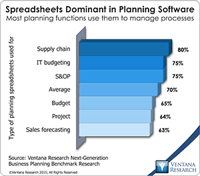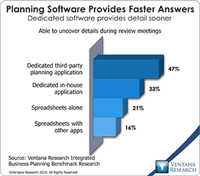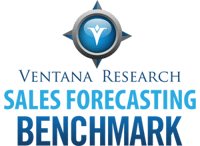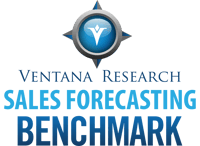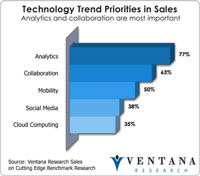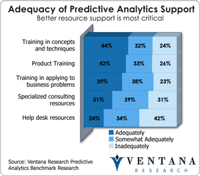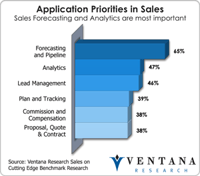Our benchmark research on next-generation business planning finds that a large majority of companies rely on spreadsheets to manage planning processes. For example, four out of five use them for supply chain planning, and about two-thirds for budgeting and sales forecasting. Spreadsheets are the default choice for modeling and planning because they are flexible. They adapt to the needs of different parts of any type of business. Unfortunately, they have inherent defects that make them...
Read More
Topics:
Planning,
Predictive Analytics,
Marketing Planning,
Reporting,
Sales Forecasting,
Budgeting,
Customer Performance,
Operational Performance,
Analytics,
Business Analytics,
Business Collaboration,
Business Performance,
Financial Performance,
Business Planning,
Demand Planning,
Integrated Business Planning
Adaptive Insights held its annual user group meeting recently. A theme sounded in several keynote sessions was the importance of finance departments playing a more strategic role in their companies. Some participating customers described how they have evolved their planning process from being designed mainly to meet the needs of the finance department into a useful tool for managing the entire business. Their path took them from doing basic financial budgeting to planning focused on improving...
Read More
Topics:
Planning,
Predictive Analytics,
Human Capital,
Marketing,
Reporting,
Sales Forecasting,
Budgeting,
Customer Performance,
Operational Performance,
Analytics,
Business Analytics,
Business Collaboration,
Business Performance,
Financial Performance,
Business Planning,
Supply Chain,
Demand Planning,
Integrated Business Planning,
Project Planning
Most people in business management admit that sales is more an art than a science. Organizations have long struggled to find the right mix to improve its effectiveness, and few get the most out of available technology. For many the default is still to use sales force automation (SFA) and spreadsheets to manage processes and try to increase the productivity of sales staff. In our view they should take a holistic approach to sales processes from contact to close and support everything from sales...
Read More
Topics:
Sales,
Recurring Revenue,
Sales Compensation,
Sales Forecasting,
Customer Performance,
Business Collaboration,
Business Mobility,
Cloud Computing,
CRM,
SFA
Business planning includes all of the forward-looking activities in which companies routinely engage. Companies do a great deal of planning. They plan sales and determine what and how they will produce products or deliver services. They plan the head count they’ll need and how to organize distribution and their supply chain. They also produce a budget, which is a financial plan. The purpose of planning is to be successful. Planning is defined as the process of creating a detailed formulation of...
Read More
Topics:
Big Data,
Planning,
Predictive Analytics,
Sales Performance,
Supply Chain Performance,
Human Capital,
Marketing,
Office of Finance,
Reporting,
Sales Forecasting,
Budgeting,
Operational Performance,
Analytics,
Business Analytics,
Business Collaboration,
Business Performance,
Customer & Contact Center,
Financial Performance,
Business Planning,
Supply Chain,
Demand Planning,
Integrated Business Planning,
Project Planning,
S&OP
Sales forecasting is an essential process for most businesses. It helps guide the efforts not only of the sales function but also of finance, operations, manufacturing and customer service. Our recently released sales forecasting benchmark research reveals significant insights and best practices that can help companies optimize the effectiveness of this process. I recently wrote that most sales organizations need to make significant changes to the way they do sales forecasting. In that analyst...
Read More
Topics:
Sales,
Sales Performance,
Sales Forecasting,
Operational Performance,
Business Analytics,
Business Intelligence,
Cloud Computing,
Information Applications,
SFA
In today’s highly competitive sales environment, where success depends on meeting the specific needs of buyers, an accurate and timely sales forecast is a critical tool for optimizing business outcomes. I discussed this as part of our 2014 research agenda for sales, noting that linking the forecast to commissions, quotas and territories is a requirement for success. We recently completed new benchmark research on sales forecasting to ascertain the state of the processes and technology sales...
Read More
Topics:
Sales,
Sales Performance,
Supply Chain Performance,
Sales Forecasting,
Sales Operations,
Operational Performance,
Business Analytics,
Business Collaboration,
Business Intelligence,
Business Performance,
Cloud Computing,
Customer & Contact Center,
Financial Performance,
Information Applications,
Information Management,
SFA
Most organizations see improving the effectiveness of sales as a way to increase productivity. Those organizations that take advantage of the latest sales applications and technology are finding themselves with a competitive advantage, but many organizations lack the time and resources to assess and deploy appropriate platforms. That’s a shame, since most sales organizations have plenty to improve in their selling, forecasting, incentives and planning according to our latest research on sales...
Read More
Topics:
Sales,
Sales Performance,
Marketing,
PIM,
Sales Compensation,
Sales Forecasting,
Operational Performance,
Business Performance,
Financial Performance,
CPQ,
CRM,
Product Information Management,
SFA
Our benchmark research on business analytics finds that just 13 percent of companies overall and 11 percent of finance departments use predictive analytics. I think advanced analytics – especially predictive analytics – should play a larger role in managing organizations. Making it easier to create and consume advanced analytics would help organizations broaden their integration in business planning and execution. This was one of the points that SPSS, an IBM subsidiary that provides analytics,...
Read More
Topics:
Big Data,
Performance Management,
Planning,
Predictive Analytics,
Marketing,
Modeling,
Sales Forecasting,
Analytics,
IBM,
Uncategorized,
SPSS
It’s clear that sales organizations need to be efficient, but many are unaware of critical applications they could deploy to establish sales excellence. In my recent analysis, “Sales Organizations Need a Swift Technology Kick”, I outlined why sales departments have to look beyond using sales force automation (SFA) and spreadsheets and examine dedicated applications for improving productivity and effectiveness. Our benchmark research in sales applications found a new set of application...
Read More
Topics:
Sales,
Sales Performance,
Social Media,
Supply Chain Performance,
Sustainability,
Sales Forecasting,
IT Research,
Operational Performance,
Business Analytics,
Business Collaboration,
Business Intelligence,
Business Mobility,
Business Performance,
Cloud Computing,
Customer & Contact Center,
Financial Performance,
Governance, Risk & Compliance (GRC),
Information Applications,
Information Management,
Location Intelligence,
Operational Intelligence,
Workforce Performance,
SFA
If you want to hit the booking and revenue targets required to operate a business, you have to manage your sales forecast and pipeline. Optimally you should be able to monitor and act upon them any day of the week and make adjustments whenever you need to. Unfortunately, most organizations have to wait until they finish their manual efforts at the end of the month or quarter, or they miss critical changes in deals and behavior because they rely only on reporting from their sales force...
Read More
Topics:
Sales,
Sales Performance,
Salesforce.com,
Social Media,
Marketing,
Revenue Performance,
Sales Force Automation,
Sales Forecasting,
Sales Operations,
Operational Performance,
Business Analytics,
Business Collaboration,
Business Mobility,
Business Performance,
Cloud Computing,
Customer & Contact Center,
Financial Performance,
Workforce Performance,
CFO,
Cloud9 Analytics,
CMO,
CRM,
Sales Performance Management,
SFA
